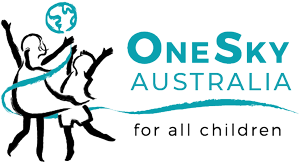A Visit to Kunming
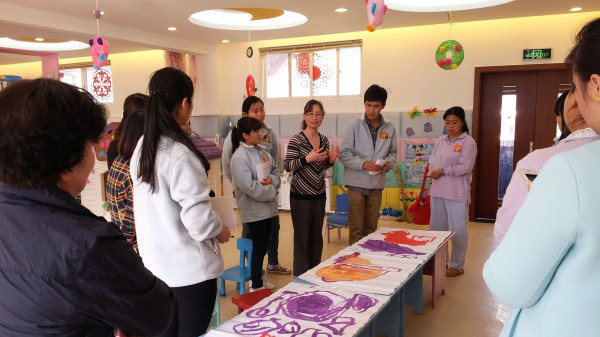 This year, I visited the Kunming CWI site for three days. When I visit a site, I always take a team of child development experts with me to provide the nannies and teachers with necessary training and support. It also is a prime opportunity to provide hands-on experience for our CDEs. This time around, I brought a group of veteran CDEs and our Preschool Director with me. I wanted to teach everyone how to effectively use coaching to nurture the children’s development.
This year, I visited the Kunming CWI site for three days. When I visit a site, I always take a team of child development experts with me to provide the nannies and teachers with necessary training and support. It also is a prime opportunity to provide hands-on experience for our CDEs. This time around, I brought a group of veteran CDEs and our Preschool Director with me. I wanted to teach everyone how to effectively use coaching to nurture the children’s development.
Before we began our work, our team met with the Kunming CWI director. He was extremely supportive and enthusiastic about Half the Sky’s programs. He promised to promote our principles so that they expand to other institutions in Yunnan province.
The director excitedly told us how earlier this year, provincial officials, city officials, and Civil Affairs officers had visited Kunming. They were highly impressed with the positive changes they saw at the institution and with the children since HTS’s programs began. He happily reported that Kunming had won the local government’s respect and support.
We then started our training in the Infant Nurture Program activity room. The room was shiny and clean, full of happy infants and toddlers being cared for by their nannies. The INP supervisor was a pleasant, capable woman, eager to do her job well.
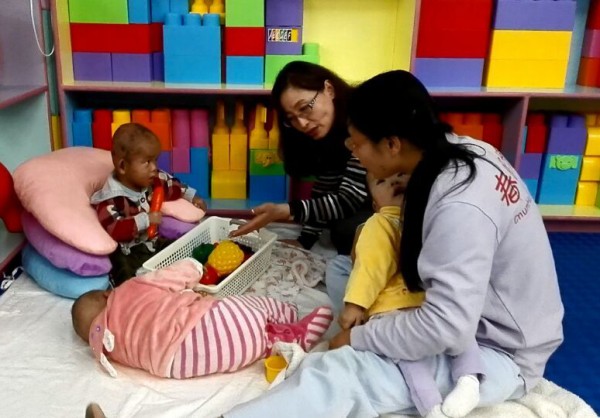 I noticed a baby lying in the same position for quite some time. This was a moment where we could help this baby. I gathered the INP supervisor, our CDEs, and the baby’s nanny together, and began a discussion about the physical, social and emotional nurture this baby needs. We showed the nanny how to change the baby’s position and exercise her muscles. This immediately elicited a positive reaction in the baby. Her eyes lit up, she became aware of her surroundings, and she smiled widely. This was a great learning experience, and proved the effectiveness and necessity for our trainings. The nanny and INP supervisor quickly went into action, demonstrating to the other nannies the techniques they had just learned, and all the babies immediately began benefiting.
I noticed a baby lying in the same position for quite some time. This was a moment where we could help this baby. I gathered the INP supervisor, our CDEs, and the baby’s nanny together, and began a discussion about the physical, social and emotional nurture this baby needs. We showed the nanny how to change the baby’s position and exercise her muscles. This immediately elicited a positive reaction in the baby. Her eyes lit up, she became aware of her surroundings, and she smiled widely. This was a great learning experience, and proved the effectiveness and necessity for our trainings. The nanny and INP supervisor quickly went into action, demonstrating to the other nannies the techniques they had just learned, and all the babies immediately began benefiting.
I also spent a lot of time training the teachers of the Little Sisters Program. The preschool classroom has 17 children, 7 with special needs children. The teachers were still learning how to teach using HTS’s child-centered philosophy, as these were very new methods and ideas for them.
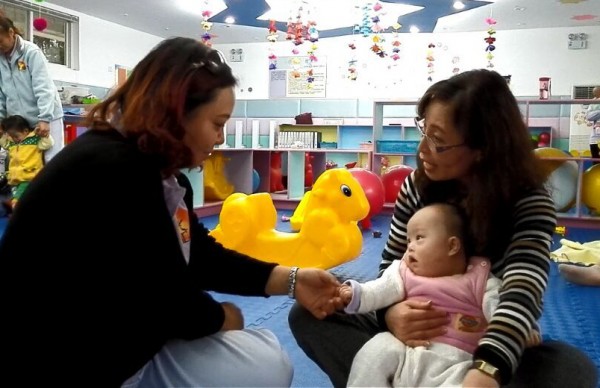 While our team was there, we worked with the teachers to add more activities and outdoor play time for the children with special needs.
While our team was there, we worked with the teachers to add more activities and outdoor play time for the children with special needs.
I learned that the children had been noticing a lot of new construction at the institution, and it had peaked their interest. Yet though they had been learning about houses and construction for three months, they were only able to draw simple houses with rectangular walls and triangle roofs. They were asking a lot of questions about houses and construction. I saw this as a perfect opportunity to help the teachers encourage the children’s curiosity. I wanted to teach them how to utilize question-based teaching practices.
I demonstrated how to ask specific questions that encouraged the children to truly observe the buildings around them. I provided art materials to engage them to focus on a construction idea. The children quickly became more talkative and engaged, expressing their observations and drawing more detailed and concrete features.
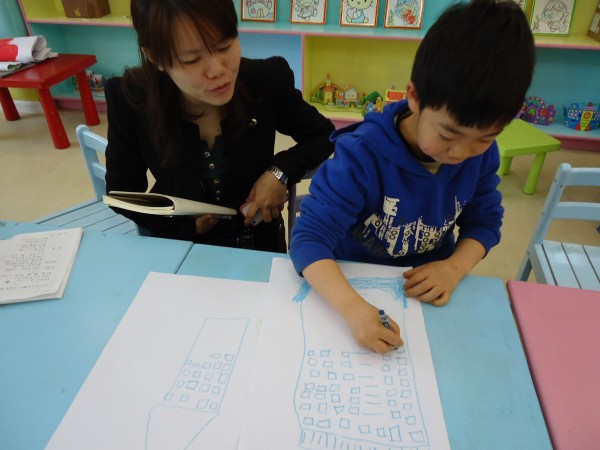 One child drew a tall building next to his classroom that he had been observing. It was complete with roof, floors and windows, all the while giving us a detailed description of the home he had created. Another child drew a family inside a house and pointed to the mom, dad, and siblings. He drew a lighter and a cup, telling us that the dad uses the lighter to smoke and says “cheers” when he drinks. His teachers were unaware that he could talk this well. Later that day, when his foster mom came to pick him up, we showed her the drawing. His mom realized the boy had been talking about the time he went to visit his parents’ hometown during Chinese New Year.
One child drew a tall building next to his classroom that he had been observing. It was complete with roof, floors and windows, all the while giving us a detailed description of the home he had created. Another child drew a family inside a house and pointed to the mom, dad, and siblings. He drew a lighter and a cup, telling us that the dad uses the lighter to smoke and says “cheers” when he drinks. His teachers were unaware that he could talk this well. Later that day, when his foster mom came to pick him up, we showed her the drawing. His mom realized the boy had been talking about the time he went to visit his parents’ hometown during Chinese New Year.
The children worked intently and talked about their drawings for well over an hour. This focus surprised the teachers. They had been assuming the children did not have very long attention spans.
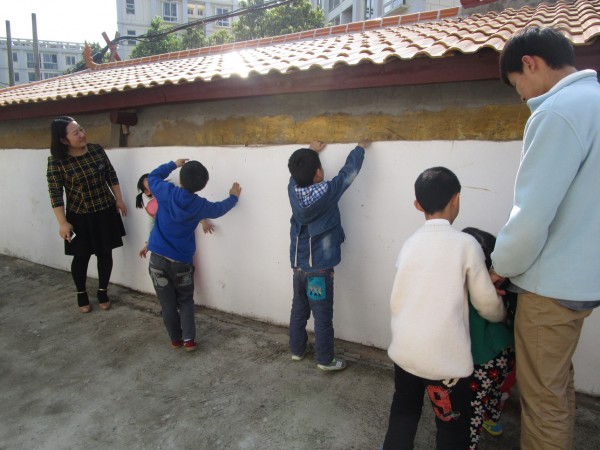 With two days of our team’s guidance, the teachers were shocked to witness the transformations that had taken place. Before, the teachers thought the children could only scribble. Now, their drawings were so detailed and included elements of their own life and families. Everyone was astonished to see how capable and competent these children are. It was obvious that those qualities thrive under the very effective teaching methods the teachers were now using. This episode taught everyone to never underestimate a child’s potential.
With two days of our team’s guidance, the teachers were shocked to witness the transformations that had taken place. Before, the teachers thought the children could only scribble. Now, their drawings were so detailed and included elements of their own life and families. Everyone was astonished to see how capable and competent these children are. It was obvious that those qualities thrive under the very effective teaching methods the teachers were now using. This episode taught everyone to never underestimate a child’s potential.
I believe that we, as adults, need to find a way to enter into a child’s world to better understand them. Connecting to children on their level promotes healthy development. When adult perception and adult-centered judgments collide with the children, the children are pushed away emotionally and cognitively, hindering their development.
During the visit, I was invited by the director to hold a leadership training workshop for mid-level administrators. This was a great opportunity to help the different departments to team up and learn how to support one another.
The LSP preschool director, Du Xiurong, also did a workshop on the topic of how children learn. This workshop helped the institution administrators understand how a nurturing and stimulating environment naturally promotes child development.
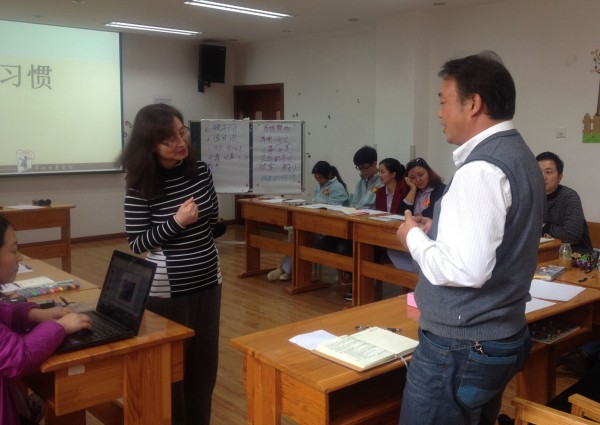 The director then sat down with all the mid-level supervisors from the institution and our team, and shared what had changed about the institution since HTS’s programs had begun. Each department head and staff members spoke about what they had observed with our program staff and what they had learned over the three days we were there. The director then gave a motivating speech to all his staff, encouraging everyone and saying that it was vital to support the HTS program, because it does so much good for the children. Everyone also made suggestions as to what the institution could do better to support the HTS programs.
The director then sat down with all the mid-level supervisors from the institution and our team, and shared what had changed about the institution since HTS’s programs had begun. Each department head and staff members spoke about what they had observed with our program staff and what they had learned over the three days we were there. The director then gave a motivating speech to all his staff, encouraging everyone and saying that it was vital to support the HTS program, because it does so much good for the children. Everyone also made suggestions as to what the institution could do better to support the HTS programs.
Everyone complimented the HTS program and its positive effects. They told how their hearts were truly touched by the changes they witnessed in the children of Kunming, thanks to the establishment of HTS’s programs. We appreciated their support and compliments. I am very grateful to have been able to play a role that caused such a profound effect by improving the quality of the institution and its programs, in such an incredibly short time.
By Wen Zhao, Senior Professional Development Director
